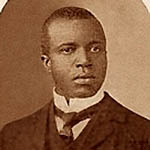
In 1899, Joplin married Belle, the sister-in-law of collaborator Scott Hayden. Although there were hundreds of rags in
print by the time the "Maple Leaf Rag" was published, Joplin was not far behind. His first published rag, "Original Rags",
had been completed in 1897, the same year as the first ragtime work in print, the "Mississippi Rag" by William Krell.
The "Maple Leaf Rag" was likely to have been known in Sedalia before its publication in 1899; Brun Campbell claimed to have
seen the manuscript of the work in around 1898. The exact circumstances that led to the Maple Leaf Rag's publication
are unknown, and a number of versions of the event contradict each other. After several unsuccessful approaches to publishers,
Joplin signed a contract on August 10, 1899 with John Stillwell Stark, a retailer of musical instruments who later became his most
important publisher. The contract stipulated that Joplin would receive a 1% royalty on all sales of the rag, with a minimum sales
price of 25 cents.
With the inscription "To the Maple Leaf Club" prominently visible along the top of at least some editions,
it is likely that the rag was named after the Maple Leaf Club, although there is no direct evidence to prove the link, and there
were many other possible sources for the name in and around Sedalia at the time.
There have been many claims about the sales of the "Maple Leaf Rag", for example that Joplin was the first musician to sell
1 million copies of a piece of instrumental music. Joplin's first biographer, Rudi Blesh wrote that during its first six months the
piece sold 75,000 copies, and became "...the first great instrumental sheet music hit in America." However, research by Joplin's later
biographer Edward A. Berlin demonstrated that this was not the case; the initial print-run of 400 took one year to sell, and under
the terms of Joplin's contract with a 1% royalty would have given Joplin an income of $4 (or approximately $118 at current prices).
TREEMONISHA (1911)
The opera's setting is a former slave community in an isolated forest near Joplin's childhood town Texarkana in September 1884.
The plot centers on an 18-year-old woman Treemonisha who is taught to read by a white woman, and then leads her community against
the influence of conjurers who prey on ignorance and superstition.
Treemonisha is abducted and is about to be thrown into a wasps' nest when her friend Remus rescues her. The community realizes the value
of education and the liability of their ignorance before choosing her as
their teacher and leader.
Treemonisha is not a ragtime opera—because Joplin employed the styles of ragtime and other black music sparingly, using them to
convey "racial character," and to celebrate the music of his childhood at the end of the 19th century. The opera has been seen
as a valuable record of rural black music from late 19th century re-created by a "skilled and sensitive participant."
As Rick Benjamin, the founder and director of the Paragon Ragtime Orchestra, found out, Joplin succeeded in performing Treemonisha for
paying audiences in Bayonne, New Jersey, in 1913. On 6 December 2011, the centenary of the Joplin piano score's publication, New World Records
released an entirely new recording of Treemonisha. August 1984 saw the German premiere of Treemonisha at the Stadttheater Gießen.
Another performance in Germany, falsely labelling itself as the German premiere, occurred on 25 April 2015 at the Staatsschauspiel
Dresden under direction and choreography of Massimo Gerardi.
Although he was penniless and disappointed at the end of his life, Joplin set the standard for ragtime compositions and played a key role
in the development of ragtime music. And as a pioneer composer and performer, he helped pave the way for young black artists to reach
American audiences of both races. After his death, jazz historian Floyd Levin noted: "Those few who realized his greatness bowed
their heads in sorrow. This was the passing of the king of all ragtime writers, the man who gave America a genuine native music."